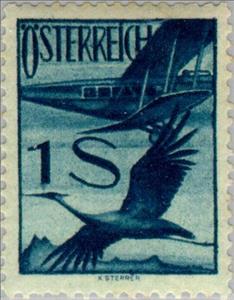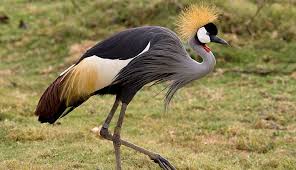Stamp: Biplane De Havilland DH 34, Common Crane (Grus grus) (Austria 1925)
Biplane De Havilland DH 34, Common Crane (Grus grus) (Austria 1925)
01 August (Austria ) within release Aircraft and bird goes into circulation Stamp Biplane De Havilland DH 34, Common Crane (Grus grus) face value 1 Austrian schilling
| Stamp Biplane De Havilland DH 34, Common Crane (Grus grus) in catalogues | |
|---|---|
| Michel: | Mi:AT 483 |
| Yvert et Tellier: | Yt:AT PA27 |
Stamp is vertical format.
Also in the issue Aircraft and bird:
- Stamp - Biplane De Havilland DH 34, Common Crane (Grus grus) face value 10;
- Stamp - Biplane De Havilland DH 34, Common Crane (Grus grus) face value 15;
- Stamp - Biplane De Havilland DH 34, Common Crane (Grus grus) face value 30;
- Stamp - Biplane De Havilland DH 34, Common Crane (Grus grus) face value 50;
- Stamp - Biplane De Havilland DH 34, Common Crane (Grus grus) face value 1;
- Stamp - Biplane De Havilland DH 34, Common Crane (Grus grus) face value 2;
Stamp Biplane De Havilland DH 34, Common Crane (Grus grus) it reflects the thematic directions:
Birds (Aves), a subgroup of Reptiles, are the last living examples of Dinosaurs. They are a group of endothermic vertebrates, characterised by feathers, toothless beaked jaws, the laying of hard-shelled eggs, a high metabolic rate, a four-chambered heart, and a strong yet lightweight skeleton. Birds live worldwide and range in size from the 5 cm (2 in) bee hummingbird to the 2.75 m (9 ft) ostrich. They rank as the class of tetrapods with the most living species, at approximately ten thousand, with more than half of these being passerines, sometimes known as perching birds. Birds are the closest living relatives of crocodilians.
Aviation is the practical aspect or art of aeronautics, being the design, development, production, operation and use of aircraft, especially heavier than air aircraft. The word aviation was coined by French writer and former naval officer Gabriel La Landelle in 1863, from the verb avier (synonymous flying), itself derived from the Latin word avis ("bird") and the suffix -ation.
Animals are multicellular, eukaryotic organisms of the kingdom Animalia (also called Metazoa). All animals are motile, meaning they can move spontaneously and independently, at some point in their lives. Their body plan eventually becomes fixed as they develop, although some undergo a process of metamorphosis later on in their lives. All animals are heterotrophs: they must ingest other organisms or their products for sustenance.
Cranes are a type of large bird with long legs and necks in the biological family Gruidae of the order Gruiformes. The family has 15 species placed in four genera which are Antigone, Balearica, Leucogeranus, and Grus. They are large birds with long necks and legs, a tapering form, and long secondary feathers on the wing that project over the tail. Most species have muted gray or white plumages, marked with black, and red bare patches on the face, but the crowned cranes of the genus Balearica have vibrantly-coloured wings and golden "crowns" of feathers. Cranes fly with their necks extended outwards instead of bent into an S-shape and their long legs outstretched.
An aircraft is a machine that is able to fly by gaining support from the air. It counters the force of gravity by using either static lift or by using the dynamic lift of an airfoil, or in a few cases the downward thrust from jet engines. The human activity that surrounds aircraft is called aviation. Crewed aircraft are flown by an onboard pilot, but unmanned aerial vehicles may be remotely controlled or self-controlled by onboard computers. Aircraft may be classified by different criteria, such as lift type, aircraft propulsion, usage and others.





